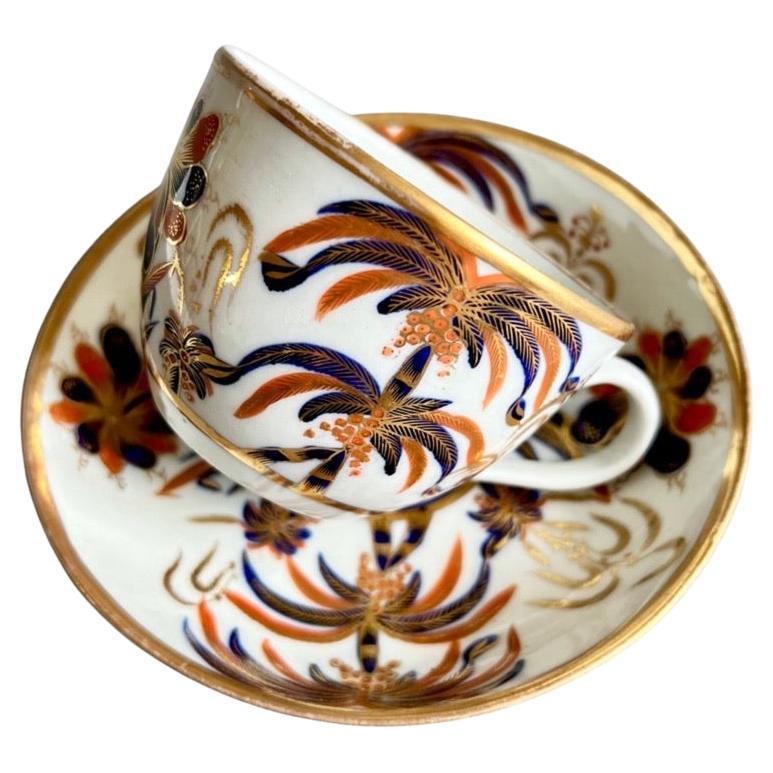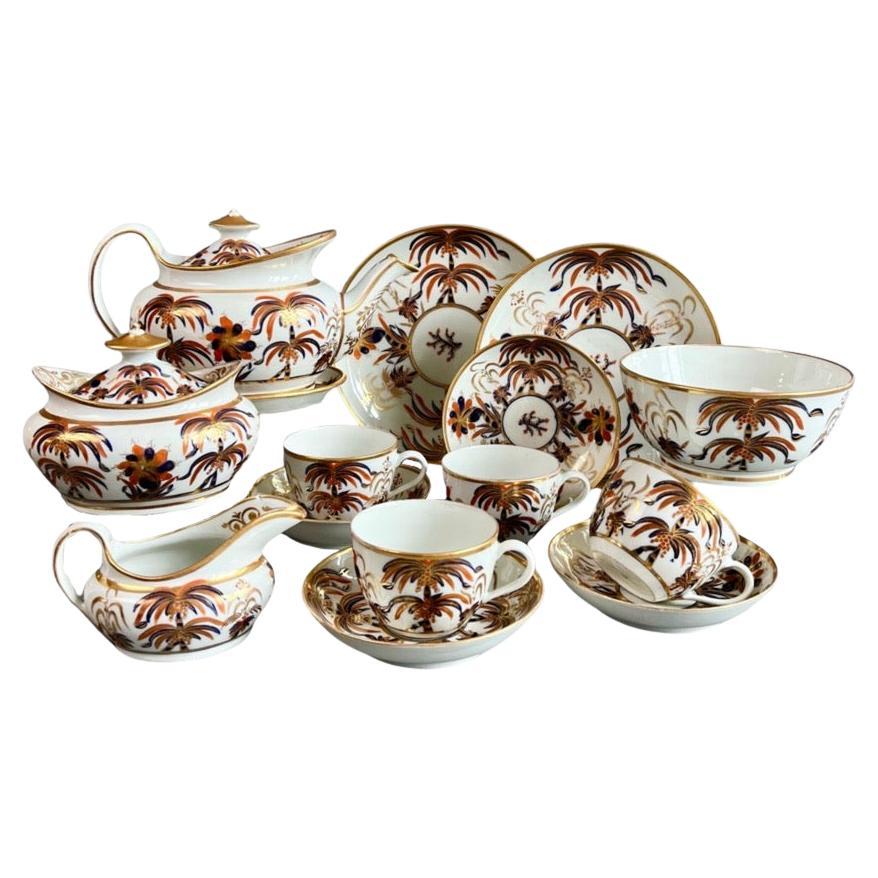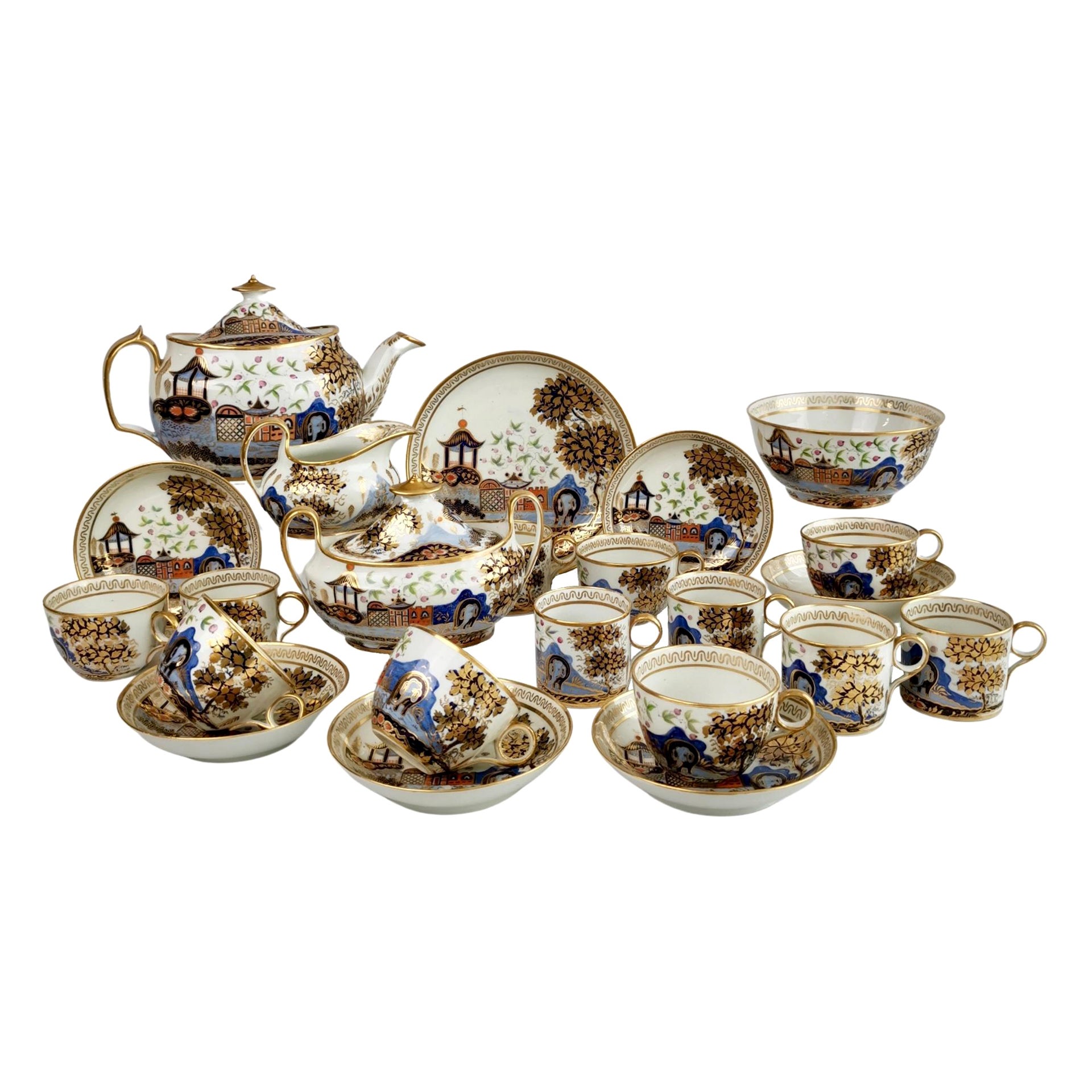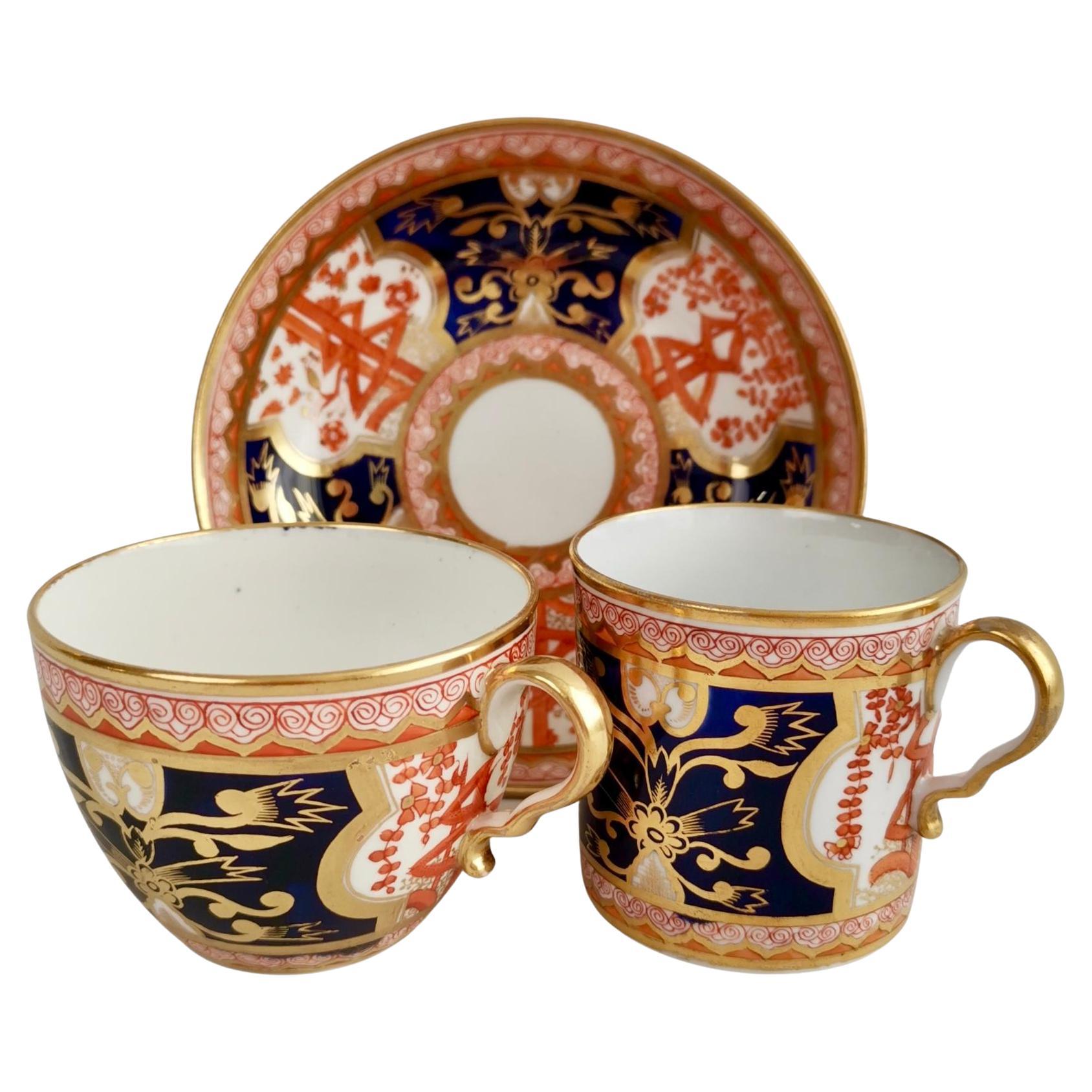Items Similar to New Hall Hybrid Hard Paste Teacup Trio, Elephant Pattern, Regency ca 1810
Want more images or videos?
Request additional images or videos from the seller
1 of 20
New Hall Hybrid Hard Paste Teacup Trio, Elephant Pattern, Regency ca 1810
About the Item
This is a beautiful true trio made by New Hall around the year 1810. The set is decorated in the very desired but rare Elephant pattern.
A true trio is how cups and saucers were sold in the early 19th Century; as you would never drink tea and coffee at the same time, the teacup and coffee can would share a saucer.
We have an entire tea service for 4 available, as well as some more separate items, please see separate listings or ask if you are interested.
The New Hall factory started as a cooperative of several Staffordshire potters making use of the porcelain license of Bristol Porcelain Company after this went in demise. It quickly grew out to be a leading porcelain maker, and the first to make true porcelain in Staffordshire. New Hall is mostly known for its huge output of its typical "hybrid hard paste" porcelain, as New Hall had adapted the original hard paste recipe from Bristol in order to save on production costs - a frugal Staffordshire improvement on the first hard paste porcelain recipes, which were quite difficult and expensive to produce. Once Josiah Spode had standardised bone china this quickly became the standard. New Hall was late to take up bone china but after 1814 they made it their main output, and they made some very high quality items.
This set is made in this typical "hybrid hard paste" porcelain, as New Hall had adapted the original hard paste recipe from Bristol (formerly Plymouth), but adapted it slightly in order to save on production costs. You can tell this by the way the porcelain is less milky than bone china. As this hybrid porcelain was slightly cheaper to make and very popular among customers who were used to the more stony Chinese Export porcelain, New Hall was a late adapter of bone china, which was already used by most other factories around the time this set was made.
The set is decorated with a gorgeous and very charming pattern called the Elephant pattern. The dominant colour is a delicate underglaze blue, with an overglaze decoration of orange buildings: a pagoda on a hill with a fortress-like entrance gate at the foot of the hill. A pomegranate tree with beautiful green foliage and puce pomegranates stands in the courtyard behind the gate. In the foreground stands an adorable elephant. The pattern was then finished with rich gilding, particularly on the tree over the elephant - he seems to be shielding himself from the sun.
The set is unmarked, which is common for items of this era.
CONDITION REPORT In perfect antique condition without any damage, repairs, crazing or even significant wear.
Antique British porcelain is never perfect. Kilns were fired on coal in the 1800s, and this meant that china from that period can have some firing specks from flying particles. British makers were also known for their experimentation, and sometimes this resulted in technically imperfect results. Due to the shrinkage in the kiln, items can have small firing lines or develop crazing over time, which should not be seen as damage but as an imperfection of the maker's recipes, probably unknown at the time of making. Items have often been used for many years and can have normal signs of wear, and gilt can have signs of slight disintegration even if never handled. I will reflect any damage, repairs, obvious stress marks, crazing or heavy wear in the item description but some minor scratches, nicks, stains and gilt disintegration can be normal for vintage items and need to be taken into account.
There is widespread confusion on the internet about the difference between chips and nicks, or hairlines and cracks. I will reflect any damage as truthfully as I can, i.e. a nick is a tiny bit of damage smaller than 1mm and a chip is something you can easily see with the eye; a glazing line is a break in the glazing only; hairline is extremely tight and/or superficial and not picked up by the finger; and a crack is obvious both to the eye and the finger. Etcetera - I try to be as accurate as I can and please feel free to ask questions or request more detailed pictures!
DIMENSIONS teacup 8.2cm (3.25") diameter; coffee can 7cm (2.75"); saucer 14.2cm (5.5").
- Creator:New Hall (Maker)
- Dimensions:Height: 1 in (2.54 cm)Diameter: 1 in (2.54 cm)
- Sold As:Set of 3
- Style:Regency (Of the Period)
- Materials and Techniques:
- Place of Origin:
- Period:
- Date of Manufacture:circa 1810
- Condition:Wear consistent with age and use. In fantastic condition without damage, repairs, or crazing and hardly any wear.
- Seller Location:London, GB
- Reference Number:
About the Seller
5.0
Platinum Seller
These expertly vetted sellers are 1stDibs' most experienced sellers and are rated highest by our customers.
Established in 2016
1stDibs seller since 2019
208 sales on 1stDibs
Typical response time: 1 hour
- ShippingRetrieving quote...Ships From: London, United Kingdom
- Return PolicyA return for this item may be initiated within 14 days of delivery.
More From This SellerView All
- New Hall Hybrid Hard Paste Teacup, Palm Tree patt. 484, Georgian ca 1810By New HallLocated in London, GBThis is a beautiful teacup and saucer made by New Hall around the year 1810. The set is decorated in the very desired but rare palm tree pattern with the number 484. We also have a ...Category
Antique 1810s English Regency Tea Sets
MaterialsPorcelain
- New Hall Hybrid Paste Porcelain Teacup, Neoclassical Cobalt Blue Gilt, ca 1810By New HallLocated in London, GBThis is beautiful teacup and saucer made by New Hall around the year 1810. The set is in decorated in the sophisticated Neoclassical style of the Regency era. We also have an entire tea service in the same pattern available, please see separate listing. The New Hall factory started as a cooperative of several Staffordshire potters making use of the porcelain license of Bristol Porcelain...Category
Antique 1810s English Regency Tea Sets
MaterialsPorcelain
- New Hall Hybrid Hard Paste Porcelain Tea Service, Palm Tree patt. 484, ca 1810By New HallLocated in London, GBThis is a spectacular 17-piece tea service serving four, made by New Hall around the year 1810. The service consists of a teapot with cover on a stand, a sucrier with cover, a milk j...Category
Antique 1810s English Georgian Porcelain
MaterialsPorcelain
- New Hall Tea Service for Six, Elephant Pattern 876, Regency ca 1810By New HallLocated in London, GBThis is spectacular full tea service for six made by New Hall around the year 1810. The service consists of a teapot with cover, a sucrier with cover, a milk jug, six trios each consisting of a teacup, a coffee can and a saucer, a cake plate (saucer dish) and a slop bowl. The set is decorated in the super-charming and popular but very rare Elephant pattern...Category
Antique 1810s English Regency Tea Sets
MaterialsPorcelain
- Spode Porcelain Teacup Trio, Red Imari Dollar Pattern, Regency, ca 1810By SpodeLocated in London, GBThis is a beautiful orphaned teacup made by Spode in about 1810. It bears a beautiful Japanese-inspired Imari pattern. Spode was the great pioneer among the Georgian potters in England. Around the year 1800 he perfected the bone china recipe that has been used by British potters ever since, and he was also the leading potter behind the technique of transferware, making it possible for English potters to replace the Chinese export china, which had come to an end around that time, with their own designs. This was fundamental to a thriving industry that would last for about 150 years and provide half the world with their tableware. Spode porcelain is regarded as one of the highest quality porcelains around; for a soft-paste porcelain it is surprisingly hard and fine, and has a wonderful bright white colour. The pattern on this can is called "Dollar" pattern, a very famous pattern that was used by English potters in the 18th and early 19th Century. It is obvious why it is called “dollar” - but its origin is less obvious! It is thought that this pattern was derived from a very old Chinese pattern depicting a tree with elaborate foliage that hides a Chinese character representing longevity or happiness. Traditionally, this went with a an image called “Taotie”, which was used on very ancient bronze vases...Category
Antique Early 1800s English Regency Porcelain
MaterialsPorcelain
- Spode Porcelain Teacup, Imari Tobacco Leaf Pattern 967, Regency ca 1810By SpodeLocated in London, GBThis is a beautiful teacup and saucer made by Spode in about 1810. The set is decorated with the famous Imari Tobacco Leaf pattern 967, which was first introduced by Spode in 1806. ...Category
Antique 1810s English Regency Porcelain
MaterialsPorcelain
You May Also Like
- Antique English Shaped New Hall Porcelain Teapot TrivetBy New HallLocated in Philadelphia, PAA fine antique English porcelain teapot trivet. Attributed to New Hall. In a diamond-shaped form. With a single red & black...Category
Antique 18th Century English Georgian Porcelain
MaterialsPorcelain
- Set of Six Porcelain Bird Teacup TriosBy Flight, Barr & Barr WorcesterLocated in New York, NYSet of six porcelain bird teacup trios. Strikingly modern looking antique set of six BFB Worcester trios of six teacups and six coffee cups with six sh...Category
Antique Late 18th Century English Empire Tea Sets
MaterialsPorcelain
- 12 Teacups and Saucers Minton Bone China Porcelain Haddon HallBy MintonLocated in Paris, FRSet of 12 teacups and with their saucers in Minton Bone China Porcelain. Famous Minton Haddon Hall model designed by John William Wadsworth (1879–19...Category
Early 20th Century English Porcelain
MaterialsPorcelain
- 12 Teacups and Saucers Minton Bone China Porcelain Haddon HallBy MintonLocated in Paris, FRSet of 12 teacups and with their saucers in Minton Bone China Porcelain. Famous Minton Haddon Hall model designed by John William Wadsworth (1879-19...Category
Early 20th Century English Porcelain
MaterialsPorcelain
- Thomas Wolfe Factory Z Lion Pattern English Teacup and SaucerLocated in Bishop's Stortford, HertfordshireA scarce antique English Staffordshire bone china teacup and saucer hand decorated with a red lion by Thomas Wolfe (Factory Z) and dating from around 1810...Category
Antique 1810s English George III Tea Sets
MaterialsPorcelain
- Swansea Welsh Porcelain Kingfisher Pattern Cabinet TrioBy Swansea PorcelainLocated in Bishop's Stortford, HertfordshireA fine antique Welsh porcelain cabinet trio decorated in the Kingfisher pattern by sought after maker Swansea and dating from around 1820. The trio comprises of a teacup, a coffee cu...Category
Antique 1820s Welsh George III Tea Sets
MaterialsPorcelain
Recently Viewed
View AllMore Ways To Browse
Antique Tea Cups And Saucers Polish
Red Gold Tea Set
Turkish Tea Glasses
Rare Teapots
Spirit Burner
Double Wall Glass Bowl
Sugar Bowl Nippon
Sugar Bowl Midcentury Chrome
Liberty Tudric 025
Alessi Teapot
Kronjyden Azur
Christofle Tea Strainer
Roger Mourre
Rose Medallion Teacups
Rosenthal 1980 Flash One
Royal Holland Pewter Tea Set
Russian Kettle
Sanborn Sterling Coffee And Tea Service





